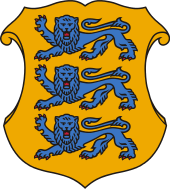Era of Silence
Part of a series on the |
|---|
| History of Estonia |
 |
|
Viking and Middle ages |
| Chronology |
|
|
The Era of Silence (Estonian: vaikiv ajastu) was the period between 1934 and 1938[1] or 1940[2] in Estonian history. The period began with the preemptive coup of 1934, which Prime Minister Konstantin Päts carried out to avert a feared takeover of the state apparatus by the Vaps Movement (League of Veterans). The term "Era of Silence" was introduced by Kaarel Eenpalu, Prime Minister in 1938-39 and a strong supporter of Päts, Estonia's dictator during that period.
Description
In the charged atmosphere that pervaded Europe in 1934, when Adolf Hitler had become a widely admired populist model for authoritarian nationalists, the Estonian elites viewed the threat of takeover by similar groups such as the Vaps movement as credible and imminent. Päts, using the authority of the newly adopted Constitution of 1933, proclaimed martial law on March 12. He appointed his trusted colleague Johan Laidoner, hero of the War of Independence but an opponent of the Vaps' leadership, as commander of the armed forces.
Veterans' organisations were shut down, over 400 of the organisations' members were arrested, and all organised political activity in the country was outlawed. All Vaps members were also purged from local governments, the civil service, and the Defence League. These actions were immediately approved by the lame-duck parliament.
However, when Päts decreed postponement of the elections for both State Elder and Parliament, scheduled to be held in spring 1934 according to the new constitution, opposition arose in a special session convened by the existing parliament, since the constitution did not allow postponement of elections by decree. In response, he permanently postponed the session and ruled by decree until a new constitution could be drawn up and adopted. Thus, Päts' takeover of the government was a coup de facto but also de jure, since the entire process was illegal under the constitution in effect in 1934.
The phrase "Era of Silence" describes the silencing of all opposition to Päts' governing circle. However, it also reflects an apparent "national conspiracy" to go along with the suppression of civil and political rights in the interests of "order" after a decade of political turmoil. His rule was not an unduly harsh one: nearly all of those jailed in 1934 were released in 1938, and none of the former heads of state (Ants Piip, Juhan Kukk, Jaan Teemant and Jaan Tõnisson) who issued the Four State Elders' Memorandum in a Finnish newspaper in October 1936, calling on Päts to immediately end the curtailment of civil and political rights and to reinstitute democratic government, was ever harassed by the government. When elections were held in 1938 under the new constitution of 1937, the opposition only managed to elect 26 members to the government's 54, which tends to support the view that the vast majority of Estonians acquiesced in the Era of Silence.
The era ended either with the national restoration of democracy in 1938, or with the Soviet occupation in 1940.
Further reading
- Frucht, R. C. (2005). Eastern Europe: An introduction to the people, lands, and culture / edited by Richard Frucht. Santa Barbara, Calif: ABC-CLIO. Page 78+
Notes
References
- Miljan, Toivo. Historical Dictionary of Estonia, pp. 196–97. Scarecrow Press, 2004, ISBN 0-8108-4904-6.
- Estonica: 1918–1940. Republic of Estonia
- Berg-Schlosser, Dirk; Jeremy Mitchell, Varrak (2000). "Estonia: Crisis and 'Pre-Emptive Authoritarianism". Conditions of democracy in Europe, 1919-39: systematic case-studies. Palgrave Macmillan. pp. 109–128. ISBN 0-312-22843-0.
